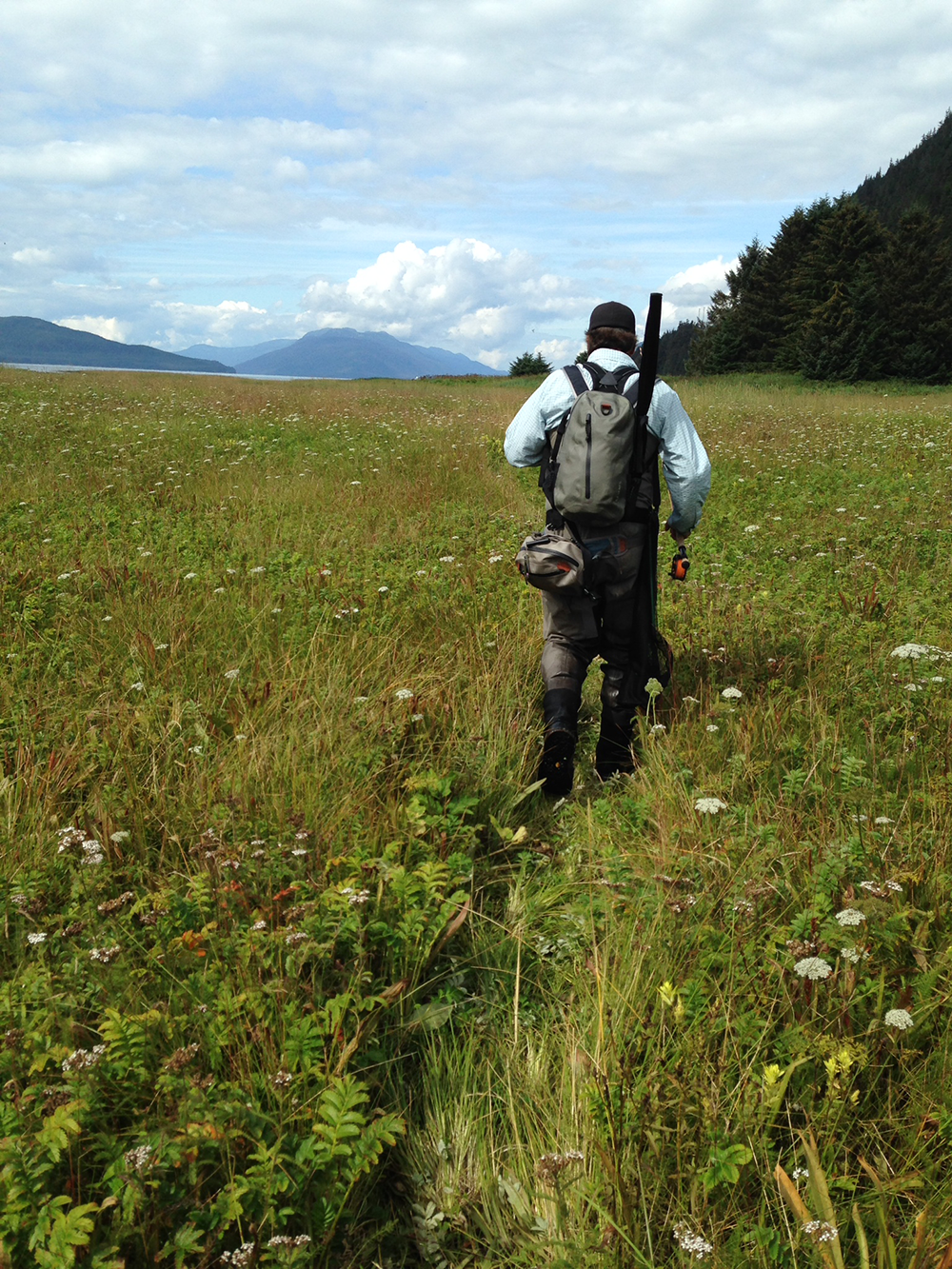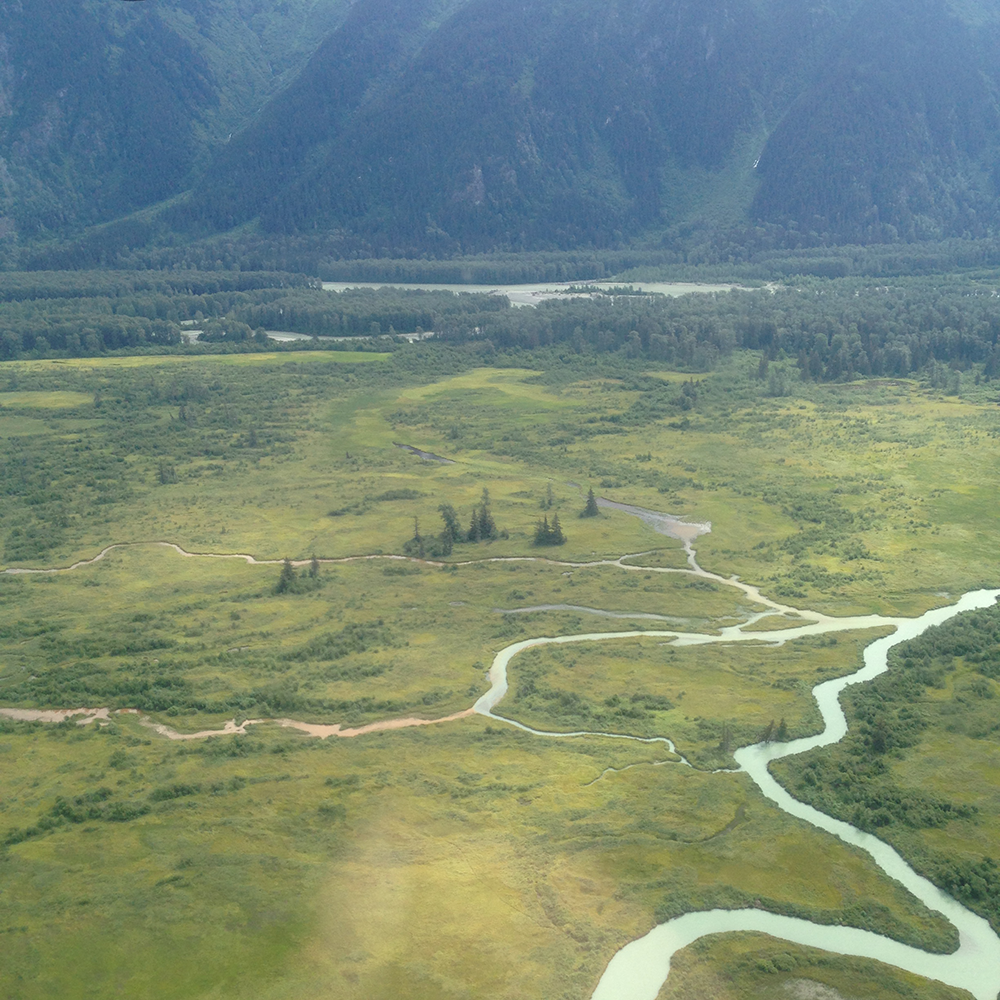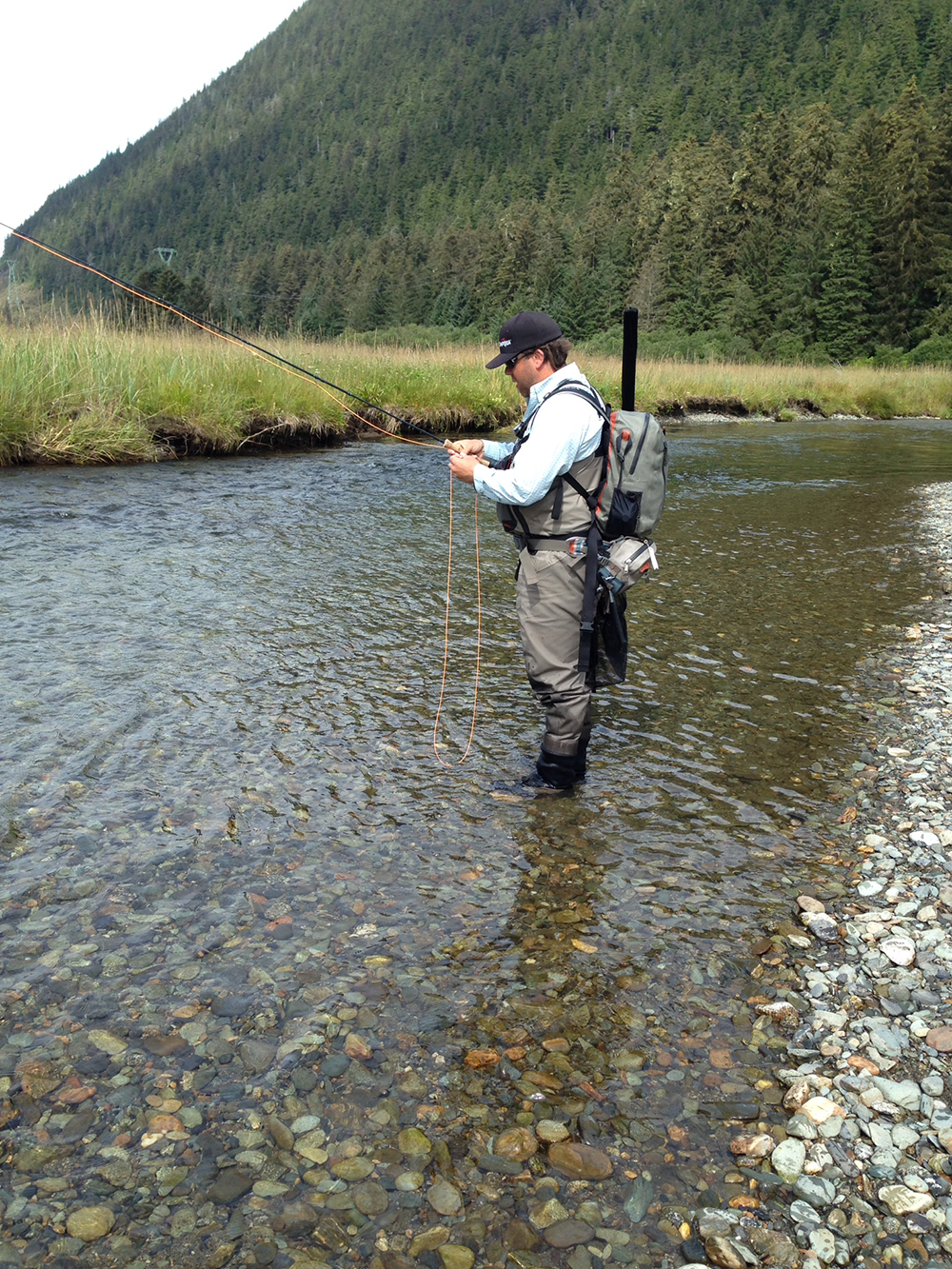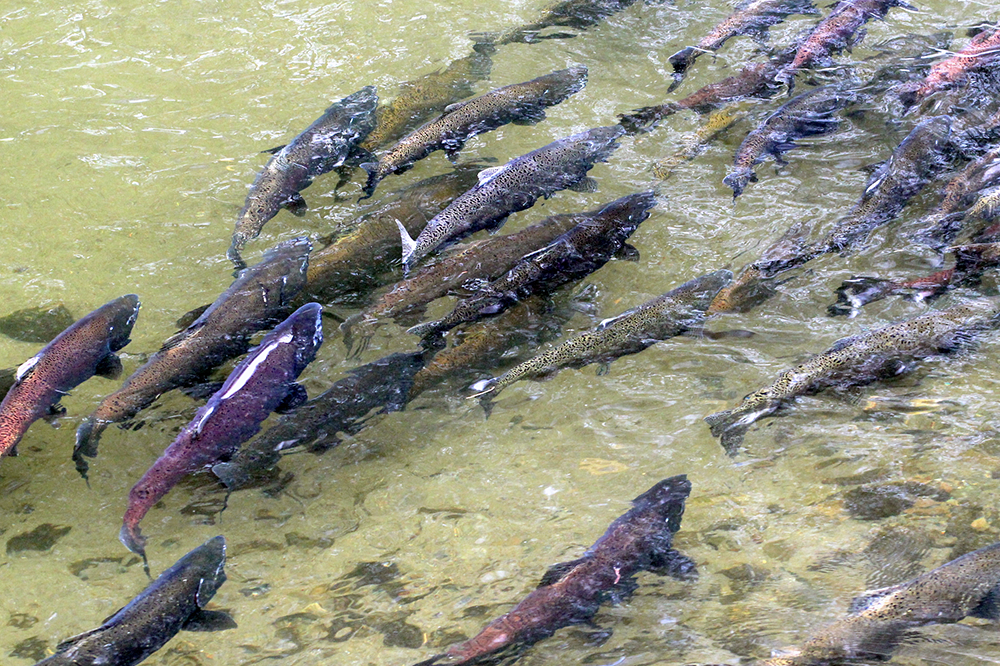Alaskan River Riches: Fly fishing and Salmon Science
Air Date: Week of August 14, 2015

Mark Hieronymus fishes in a stream just outside of Juneau. (Photo: Emmett FitzGerald)
In the summer of 2014, Living on Earth’s Emmett FitzGerald visited Southeast Alaska to report on the salmon economy and potential threats from new mining development over the border in British Columbia. In this report, he wades into a stream near Juneau for a lesson in casting and salmon science from a fly-fisherman with a conservation ethic. Emmett FitzGerald then joins host Steve Curwood to discuss how mining projects have moved forward since his visit and how Alaskan locals are responding.
Transcript
CURWOOD: It's an encore edition of Living on Earth. I'm Steve Curwood. Summer in Southeast Alaska is salmon season. As the days grow long, the iconic fish begin to run up rivers and streams, and the fishing economy jumps to life. Juneau isn’t the biggest fishing town in the region, but salmon are everywhere: on every restaurant menu, on T-shirts in gift shops. And in the harbor, hundreds of fishing boats constantly come and go. Just a few miles outside of the city, small commercial fishing boats cruise around the mouth of the great Taku River, netting the salmon as they head upstream. Juneau is also a popular jumping-off point for fly-fishing trips, and sport fishing is an important source of income. Living on Earth’s Emmett FitzGerald spent some time in Juneau in the summer of 2014, reporting on the fish, their importance to the people who live there – and potential threats to the salmon that drive the local economy. And a fly-fisherman with a conservation ethic gave Emmett a lesson in casting and salmon science.
FITZGERALD: It’s a blue summer day, about as warm as it gets in Southeast Alaska. Fly-fishing guide Mark Hieronymus has the morning off, but he’s more than happy to spend it at one of his favorite fishing holes—although he’s not about to let me give away the precise spot on national radio.
HIERONYMUS: You could say that we’re at a small stream very close to the mouth of Taku River in Taku inlet.
[SOUND OF TRAMPING ALONG BANKS]
FITZGERALD: In chest high waders, we tramp along the pebbled banks. Where the stream narrows, Mark wades in and we slosh across to the other side.
[SOUND OF SLOSHING WATER]
FITZGERALD: The rushing water squeezes the waders tight and cold against my legs, and I have to lean into the current to avoid toppling over.
[SOUND OF SLOSHING WATER CONTINUES]
FITZGERALD: On the other shore Mark sets up shop. He puts his pole together, ties on a feathery orange fly, and starts showing me how it’s done.
HIERONYMUS: You’re going to go like this with this rod, you’re gonna cast it back out there and you want to cast this kind of gentle, so I’ll show you this cast called a roll cast.
FITZGERALD: OK.
HIERONYMUS: If it ever tightens up, that’s a fish.
FITZGERALD: There’s so many fish in this stream that even I manage to get a few bites, but Mark’s the real master here. As the line dances back and forth above his head, he tells me about the different salmon in Southeast Alaska.
HIERONYMUS: The largest of those in terms of numbers are pink salmon. The run sizes fluctuate but this year, to give you an idea, this is going to be a poor run of pink salmon this year and they’re projecting a harvest of around 22 million with a total escapement of somewhere over 30 million.
FITZGERALD: There’s five salmon species in all. As well as the pink there’s Chum, Coho, Sockeye…

Hiking in, fishing pole in hand. (Photo: Emmett FitzGerald)
HIERONYMUS: And then we get King Salmon too, that run in here. Those are the commercially caught fish and then we have also steelhead, which is the anadromous form, the ocean going form, of rainbow trout. That’s sort of the prized sport fish, that’s the crown jewel of most sport catches and here in Southeast Alaska we have officially about 330 streams with steelhead in them. But if you talk to folks that have fished for them for a long time they’ll tell you that that number is closer to 450 streams of steelhead in ’em.
FITZGERALD: This one?
HIERONYMUS: This one does have Steelhead but you don’t have to print that.
FITZGERALD: Mark lands his fly a few feet from the opposite bank, just above a cluster of dark shadows hanging in the water. They look like rocks to me, but Mark says they’re pink salmon, or as he calls them, humpies after the characteristic hump on back of the male. These humpies are in their final days of life, waiting for more salmon to join them upstream. When they get a quorum, they’ll spawn and die.
HIERONYMUS: These humpies have a two-year life cycle. So these fish here when they spawn, they’ll die and they enrich the stream here. And the young swim out to sea next year, next spring. Those fish will return in 2016 in the same numbers, sometimes even more.
FITZGERALD: It doesn’t take long for Mark’s fly to get some action.
HIERONYMUS: Well, this is a pink salmon. Looks like a female, and it’s a little one -- grabbed it.
[SOUNDS OF FLOPPING AND SPLASHING]
FITZGERALD: There you go.
HIERONYMUS: Yeah. It’s got a little nip on the outside of him there. There’s seals that sit out off of this--the river mouth here--and the seals’ll try to grab the fish.
FITZGERALD: Wow, look at that thing. So you think that wound there is a seal?
HIERONYMUS: Yeah that’s most likely a seal; it’s pretty fresh.
FITZGERALD: Is that going to be life-threatening to that fish?
HIERONYMUS: Well, the thing about it is this fish is on its spawning run, so its days are numbered right now, and so that wound might get infected, but that’s not going to be the cause of it dying. The cause of it dying is going to be—it’s on its spawning run; it was gonna die anyway.

A tributary in the Taku River Valley, a major salmon river that flows into the sea outside of Juneau. (Photo: Emmett FitzGerald)
FITZGERALD: The salmon life cycle is a well-documented natural wonder. Somehow, each fish manages to find its way back from the open ocean to a little stream like this one, where it was born. Scientists think they use the earth’s magnetic field and their sense of smell to help them get back home, but it’s still a bit of a mystery.
This summer, though, the salmon cycle was disrupted on one of the biggest sockeye rivers in North America. On August 12th, a dam holding back waste water from the Mt. Polley copper and gold mine in British Columbia burst, sending over 6 billion gallons of polluted water and mine waste into the Fraser River, just as the sockeye had begun to swim upstream. Mark says that as he watched the horrific images on the news, all he could think about was the salmon.
HIERONYMUS: Once they enter fresh water on their spawning run, their time is limited. And so they have to find clean gravel and have clean water to spawn in. That’s the whole reason these fish come back. So if there’s no place for them to do it or if the habitat is compromised, then the results are, potentially, you’re missing an entire year class of fish.
FITZGERALD: Canadian officials say the Fraser River Sockeye have weathered that spill fairly well, but it’s way too early to know what the long-term impact on the population will be. The wastewater was filled with heavy metals that could linger in the rivers and lakes for years to come, and that’s bad news for the salmon.
HIERONYMUS: What people don’t think about are the effects of some of these harmful toxins to phytoplankton or in-stream invertebrates. And if you lose that food base, then you’re going to lose the fish. It’s not an “if.” If there’s nothing there for them to live on, then you lose the fish. You’re basically ripping out the bottom of the food chain and the fish follow.
FITZGERALD: Mark hopes that the Mount Polley disaster is a wake-up call about the dangers of mining in sensitive watersheds. British Columbia is in the middle of a mining boom, and several BC mines are planned along rivers that flow right into Southeast Alaska—rivers like the Unuk, the Stikine, and the Taku, near where we are right now. Mark says that if anyone doesn’t understand why these projects are a bad idea, just look at Mount Polley.
HIERONYMUS: The potential for something like that to happen, as we’ve seen, has now gone up greatly, because it has happened. And so to have it happen in a place that produces, place like, say, the Taku valley, or the Stikine valley, or the Unuk valley, that produces a substantial amount of Southeast Alaska’s fish, frankly it’s fairly horrifying.
FITZGERALD: As he talks, Mark is constantly casting, his arm rocking back and forth with a practiced finesse. He lays the line down on the water and lets the fly drift through the salmon shadows. If they don’t bite in five seconds, he yanks it out and starts again. For Mark, protecting fish is a personal economic issue. He’s had a lot of different jobs since moving to Juneau 25 years ago—seafood processor, fly designer, and today, as well as being a fly-fishing guide, he’s the Sportfish Outreach Coordinator for Trout Unlimited Alaska.

Mark is a fly-fishing guide based in Juneau. He takes tourists out on day-trips to streams like this one. (Photo: Emmett FitzGerald)
HIERONYMUS: People, when they find out I work for Trout Unlimited, they say, is that some kind of environmentalist organization? I say, no, we’re conservationists, there’s a big difference. I want to conserve it, so I can keep killing it and keep making money off of it. But they have to be around for me to do that.
FITZGERALD: Before long, Mark’s got another fish on the line.
[SOUNDS OF SPLASHING WATER]
FITZGERALD: He pulls the salmon out of the water. It’s another female, he says.
HIERONYMUS: The thing that people don’t really realize is that, if we give these guys fresh water – clean water – and a good habitat to spawn in, the management is such that these fish come back year after year after year and we can keep making money on ’em.
FITZGERALD: Mark pulls the hook out of the lip and slides the fish back in the water. It lingers for a moment then swims off. In only a few weeks, he says, she’ll lay her eggs and die. But if the water stays clean and the habitat healthy, he’ll be back on this bank in two years, trying to catch her children.
For Living on Earth, this is Emmett FitzGerald in Juneau, Alaska.
CURWOOD: So, Emmett, it’s been – what – a year since you visited Alaska, and I want to hear how things have moved on since then. Mark Hieronymus talked about this horrendous spill at the Mt. Polley mine. How’s that river doing and how are the salmon, a year after that?
FITZGERALD: Well, it’s a little too early to tell about this summer’s run. In fact, scientists are actually more worried right now about the weather than the Mt. Polley situation. They’ve had a really hot summer – you’ve heard about these wildfires in the Pacific Northwest – and the water’s really, and the level is really low, and that's tough on salmon. But in terms of the spill itself, it’s still unclear what the overall impact will be. It could take years for those toxins to work their way up the food chain and actually start affecting the fish. But salmon advocates in Southeast are worried, because they’re actually talking about reopening the mine.
CURWOOD: Really?
FITZGERALD: Yeah, the mining company got approval to begin limited operations. They still need more permits before they get back to where they were before. But yeah, people are pretty concerned. There was an independent report that looked into the situation at Mt. Polley to determine what went wrong and make some recommendations. And many of the activists that I talked to are saying that the recommendations they made – things like not storing mining waste in watery ponds, which flood out into rivers – those sorts of recommendations aren’t being followed as the mine reopens.
CURWOOD: And, Emmett, it’s not just the Mt. Polley mine; in the piece the fisherman Mark Hieronymus mentioned a mining boom in British Columbia, huh?

King Salmon gather together to spawn. (Photo: Bigstockphoto)
FITZGERALD: Yeah, British Columbia is in the process of developing a series of metal mines along the border with Southeast Alaska. And most of them are in really important salmon watersheds – rivers that flow from British Columbia over the border into Southeast Alaska. They’re mines like Shaft Creek, Galore Creek, Tulsequah Chief, Red Chris, and then the one that’s gotten the most media attention is the KSM mine – Kersel Fretz Mitchell. And that’s a massive copper and gold mine that’s being developed in the headwaters of the Unuk River, which is a big transboundary river, they call it, which flows from British Columbia into Southeast Alaska and empties out right next to Juneau, the state capital. KSM has gotten the go-ahead from BC, but it’s spinning its wheels now, more along financial lines, for financing reasons. It’s a huge, huge project – they need billions of dollars of investment, and they just don’t have that yet.
CURWOOD: So how are the people in Alaska responding to all this mining development?
FITZGERALD: Well, commercial fishermen and native Alaskans, in particular, in the area have really been up in arms about KSM and all of these other mines. They’re saying there just isn’t a strict enough environmental review in British Columbia. The waste from mining operations is called tailings, and when it comes to the surface, it can interact with the air and become acidic, and very toxic to fish. And what people in Southeast Alaska are saying is, you know, we don’t get any of the jobs, or any of the benefits from these projects, but we incur all the risk, when those tailings have the potential to wash into the rivers and flow downstream and hurt their fish populations. So they’re looking at Mt. Polley and saying, this is a perfect example of what can go wrong with these kinds of massive mining projects.
CURWOOD: So, how is the Alaskan state government and the federal government responding to these concerns?
FITZGERALD: Well, a lot of activists that I spoke with aren’t all that happy with the state response. I spoke with Kyle Mosele from the Alaska Department of Natural Resources, and he says you know, he trusts British Columbia’s regulatory processes on these things – which is not a view that’s shared by some of the fishermen I spoke with. The environmental activists have tried to get past the state and go to the federal level. They’re calling on the State Department to invoke the 1909 Boundary Waters Treaty, which has been used in the past to regulate rivers that flow across national borders. But the State Department, for now at least, seems pretty reluctant to get involved. They’ve said it's more of a local issue, in their opinion. BC minister of mines Bill Bennett is coming to Alaska in late August, and he’s going to meet with state government officials about this. And activists really want them to come to a strict agreement that will deal with what happens when a spill occurs and has downstream impacts on Alaska.
CURWOOD: So have any of these mines actually opened?
FITZGERALD: Well, the one that’s furthest along is Red Chris. That’s a copper and gold mine owned by Imperial Metals, the same owner as Mt. Polley. And it’s being developed in the headwaters of the Stikine River, which is another one of these major transboundary rivers that flows into Southeast Alaska near the little town of Wrangell. And you’re going to here more about Wrangell and the Stikine later in the show. But it’s a big salmon river, not a lot of development on it now. And people in the town are very concerned about this project. The local government wrote a letter in support of the Federal Government getting involved, through the Boundary Waters Treaty. And the Native Tlingit people are also very concerned, and are also calling on the federal government to get involved. But across the border, the Tahltan First Nation in British Columbia actually reached an agreement with the owner Imperial Metals. And they’re going to be getting some of the profits and some jobs out of the deal, and partially as a result, that mine has opened up. And it’s ramping up its operations as we speak.
CURWOOD: Living on Earth’s Emmett Fitzgerald. Thanks so much, Emmett!
FITZGERALD: Thank you.
Links
Read more about fly-fisherman and conservationist Mark Hieronymus
Living on Earth wants to hear from you!
Living on Earth
62 Calef Highway, Suite 212
Lee, NH 03861
Telephone: 617-287-4121
E-mail: comments@loe.org
Newsletter [Click here]
Donate to Living on Earth!
Living on Earth is an independent media program and relies entirely on contributions from listeners and institutions supporting public service. Please donate now to preserve an independent environmental voice.
NewsletterLiving on Earth offers a weekly delivery of the show's rundown to your mailbox. Sign up for our newsletter today!
 Sailors For The Sea: Be the change you want to sea.
Sailors For The Sea: Be the change you want to sea.
 The Grantham Foundation for the Protection of the Environment: Committed to protecting and improving the health of the global environment.
The Grantham Foundation for the Protection of the Environment: Committed to protecting and improving the health of the global environment.
 Contribute to Living on Earth and receive, as our gift to you, an archival print of one of Mark Seth Lender's extraordinary wildlife photographs. Follow the link to see Mark's current collection of photographs.
Contribute to Living on Earth and receive, as our gift to you, an archival print of one of Mark Seth Lender's extraordinary wildlife photographs. Follow the link to see Mark's current collection of photographs.
 Buy a signed copy of Mark Seth Lender's book Smeagull the Seagull & support Living on Earth
Buy a signed copy of Mark Seth Lender's book Smeagull the Seagull & support Living on Earth

